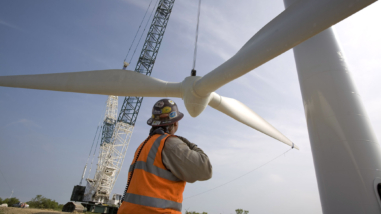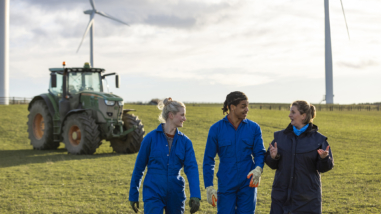This is the third in a five-part series by Hewlett Environment Program Officer Erin Rogers about what charitable philanthropists and nonprofits are learning about ways to convert widespread public support for clean energy and other climate solutions into policy action that can ensure a safer climate for all. Looking at – and beyond – Hewlett’s own grantmaking, Erin shares bright spots where groups are working together to build what academics call “political will” – the complex ecosystem of social forces that help decision makers prioritize problem-solving.
Read part one: Building political will for climate action
Read part two: Depolarizing climate action through supporting diverse ecosystems of organizations
Read Part four: The heart-mind connection
After much prodding from friends, I recently read Yuval Harari’s sweeping history of the human race, Sapiens. In it, he theorizes that Homo sapiens developed language 70,000 years ago in part to gossip – to share information about who could be trusted, who is honest, who is cheating, who is free-loading. This enabled small bands of Homo sapiens to grow into larger bands, developing ever tighter and more sophisticated forms of cooperation. This prowess at social cooperation enabled them to triumph over Neanderthals and other human species that existed at the time.
It appears as though effective cooperation and collaboration techniques are still critical to our survival as a species. Relationships and networks that are built on trust are key to solving complex social and planetary problems like climate change.
According to a recent evaluation of 25 collective impact initiatives, the top two conditions for achieving systems and policy change were 1) building and enhancing collaboration and 2) strengthening partnerships. And, a collaborative leadership style (which, based on my experience, is often embraced by women and often under-valued) matters. Philanthropy is uniquely well-suited to fund the leaders and the infrastructure that foster trust, partnerships, and collaboration.
One type of collaboration that stands out as especially deserving of mention is between grassroots community members and those who have advocacy expertise and constructive relationships with decision makers. When this connective tissue (whether within the same group or across groups) is flexed to demonstrate that policy advocates and a decision maker’s constituents are actively united, the collective effort is more likely to be successful in moving a policy forward than either component alone.[1] This connection has proven to be more important than sheer numbers of group membership or public opinion percentages.[2]
Grantees are clamoring for support in making these connections more robust and sustained over time. Funders, on the other hand, often fund in boom and bust cycles, forcing grantees to swoop in and out. This can break hard-won trust and leave the difficult work of policy implementation under-resourced. During implementation, newly adopted policies are often subject to drifting (or being shoved back) toward the status quo ante if the surrounding political context remains the same.[3] Sustained connection between grassroots voices and policy advocates can help avoid energy spent on defense and instead supercharge durable forward momentum.
Illinois offers a good example. For years, efforts to fix Illinois’ broken renewable energy standards had been caught in a hamster wheel with the same voices, the same environmental coalition challenges, and the same outcome year after year: no progress. Philanthropy’s increased support for better connections between grassroots constituents and policy advocates proved pivotal in effectively leveraging a window of opportunity opened by an economic crisis at the state’s largest utility to move significant climate solutions forward.[4]
During this intense campaign in 2016, the Illinois Consumer Utility Board (CUB), which represents the interests of residential utility customers across the state, mobilized its members to weigh in. CUB Executive Director David Kolata explained that, “our traditional membership is largely senior citizens – many on fixed incomes. They understood that cleaner energy would actually lower bills for everyone. When those grandmas and grandpas spoke in their own voices, they not only had standing as ratepayers, but they also commanded moral authority as seniors, and decision makers definitely paid attention.”
Rev. Booker Steven Vance at Faith in Place and Juliana Pino of Little Village Environmental Justice Organization made sure that the voices of grassroots people of color were also at the table. They tied the pending clean energy boom to criminal justice reform, advocating for clean energy job training and jobs for returning citizens (formerly incarcerated), graduates of foster youth programs, and others in need.
“For members in our congregations and communities, making the connection between renewable energy policy and social justice is not a stretch – it’s core. When our members talk about these connections, around real needs in the challenged communities and shared values, decision makers get it in a different way,” Pastor Vance said. “Our experience is that making these kinds of connections is much more impactful than talking about the technical specs of the policy alone.”
The environmental groups were able to bring the deep policy knowledge that transformed those ideas from concepts into policy frameworks, and help grassroots constituents connect effectively with decision makers.
The campaign was able to garner broad bipartisan support for new clean energy policies that achieved emission reductions by replacing fossil-fueled energy and adding massive amounts of new wind and solar energy onto the grid. It also included energy efficiency programs that will lead to a cumulative $6 billion in ratepayer savings over time, special efficiency programs for low-income households, a $10 million job development program and 2,000 reserved jobs for returning citizens and foster family alum.
As University of California Santa Barbara Professor Hahrie Han’s research points out[5], when grassroots groups and policy groups stay connected over time, their impact becomes even more powerful.
In the Illinois case, the broad coalition continues to work together to implement the policies they’d worked so hard to win. They were recently able to convince the Illinois Commerce Commission to meet all of the policy goals, eight years early. With the climate clock ticking, moving quickly to put clean energy policies into place matters. The Commission’s implementation plan also contains a significant equity component providing substantial funding for low-income rooftop and community solar projects, solar projects connected to nonprofits and public facilities that serve low-income communities, and a $50 million allocation for low-income community solar pilot projects that prioritize local hiring, community partnerships, and subscriptions focused on community residents and organizations.
Now, the coalition is looking ahead for ways to keep building on the momentum they’ve built. They are exploring paths to 100 percent clean energy by 2050 – truly transformational change – as well as other ambitious targets.




